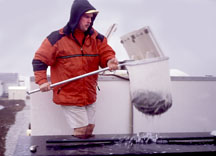 Purdue News
Purdue News
 Purdue News
Purdue News
December 19, 1997

|
For the first experiment, Swann has stocked three of the ponds with 750, 1,000 and 1,250 rainbow trout. He said he hopes each pond ultimately will yield about 4 pounds per fish.
In addition to determining the productivity of different stocking densities, Purdue scientists also will look at over-winter water temperatures, ice management and winter feeding.
Midwest aquaculture is in the fingerling stage as an industry, Swann said, with about 100 fish farmers in Indiana, and possibly 1,000 in the Midwest. The predominant method of production is open pond, similar to the Purdue setup. The research at the Purdue ponds should provide answers to many questions for these producers, who are getting in on the early phases of the industry's growth in the Midwest.
In addition to the research benefits, the Purdue aquaculture facility will provide hands-on teaching opportunities. Purdue Professor Paul Brown said both graduate and undergraduate students from animal sciences and forestry and natural resources will work at the facility.
"They'll experience every aspect of taking care of aquatic animals," Brown said, "feeding, disease diagnosis, every aspect." Brown's research involves adapting Midwestern crops such as soybeans for use as fish food.
Brown and molecular geneticist Paul Collodi said they expect aquaculture to become a more important industry for the Midwest and the United States. Although consumption of seafood in the United States is increasing, most wild U.S. fisheries are harvested at or near maximum sustainable yields, and many have actually declined in terms of catch, Collodi said. As a result, there has been an increasing reliance on aquaculture to satisfy the demand for aquatic food species. As this shift from wild populations to artificially propagated aquatic species continues, optimization of aquaculture methods will be necessary to maximize food production, he said.
Collodi has been researching genetic methods of improving productivity and suitability of fish for aquaculture. Using embryo cell cultures, he has been evaluating hormonal factors that control fish development and growth. "We are also working to develop genetic methods that can be used to alter certain characteristics of the aquatic species, making the organism more suitable for culture," Collodi said. "This could include making some popular warm-water fish species more tolerant of cold temperatures."
Collodi and Brown's research is partially supported by Illinois-Indiana Sea Grant College Program, which has its headquarters at Purdue. Swann works for Purdue and Sea Grant as an aquaculture specialist for both states.
Sources: LaDon Swann, (765) 494-6264; e-mail lswann@ansc.purdue.edu
Paul Brown, (765) 494-4968
Paul Collodi, (765) 494-9280; e-mail, pcollodi@ansc.purdue.edu
Writer: Andrea McCann, (765) 494-8396
Purdue News Service: (765) 494-2096; e-mail, purduenews@purdue.edu
PHOTO CAPTION:
Purdue aquaculture specialist LaDon Swann stocks Purdue's new experimental fish farming
ponds with rainbow trout. The project will help Midwest cold-water fish farmers.
(Photo provided by LaDon Swann)
Color photo, electronic transmission, and Web and ftp download available. Photo ID:
Swann.Ponds
 To the Purdue News and Photos Page
To the Purdue News and Photos Page